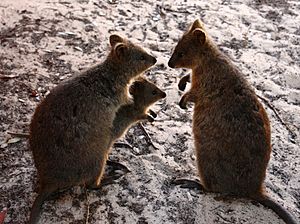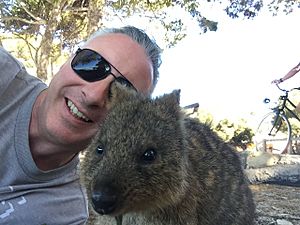Quokka facts for kids
Quick facts for kids Quokka |
|
|---|---|
 |
|
| Conservation status | |
| Scientific classification | |
| Genus: |
Setonix
|
| Species: |
brachyurus
|
 |
|
| Geographic range | |
The quokka, also known as the short-tailed scrub wallaby (Setonix brachyurus), is a small animal. It is about the size of a house cat. This cute creature is a type of macropod, like kangaroos and wallabies. The quokka is the only animal in its group, called Setonix. Quokkas are herbivores, meaning they only eat plants. They are also mostly nocturnal, which means they are active at night and sleep during the day.
Contents
What is a Quokka?
A quokka usually weighs between 2.5 and 5 kilograms (5.5 to 11 pounds). It is about 40 to 54 centimeters (16 to 21 inches) long. Its tail is shorter than other macropods, measuring 25 to 30 centimeters (10 to 12 inches). Quokkas have a strong body, powerful back legs, round ears, and a short, wide head.
Even though they look like tiny kangaroos, quokkas can climb small trees and bushes. They can climb up to 1.5 meters (5 feet) high! Their fur is rough and brown, fading to a lighter color underneath. Quokkas typically live for about 10 years. During the day, they sleep hidden in spiky plants called Acanthocarpus preissii to stay safe.
Discovery and Name
The first time a quokka was written about was in 1658. A Dutch sailor named Samuel Volckertzoon saw what he thought was a "wild cat" on Rottnest Island. Later, in 1696, another Dutch explorer, Willem de Vlamingh, thought they were giant rats. He named the island 't Eylandt 't Rottenest, which means "rat nest" in Dutch.
The name "quokka" comes from a word in the Nyungar language. The original word was probably gwaga.
Where Quokkas Live
Quokkas live on some smaller islands off the coast of Western Australia. You can find them especially on Rottnest Island, near Perth, and Bald Island, near Albany. There are also a few small groups living in forests and coastal areas between Perth and Albany. A tiny group also lives in a protected area called Two Peoples Bay Nature Reserve.
Quokka Habitat
On the mainland, quokkas like places with lots of plants. This gives them different foods to eat and places to hide from animals that might hunt them, like dingoes, red foxes, and feral cats. On Rottnest Island, quokkas are very common. They live in many different places, from dry scrublands to gardens.
They love to sleep during the day in spiky Acanthocarpus plants. These plants are hard for humans and other large animals to walk through, making them safe hiding spots. Quokkas are also known for being able to climb trees.
Quokka Reproduction
Female quokkas give birth to one baby, called a joey, after about a month of pregnancy. A female can have two babies in a year. Over her lifetime, she might have around 17 joeys. The joey stays in its mother's pouch for six months. After leaving the pouch, the joey still drinks its mother's milk for two more months. It is fully grown and independent around eight months old. Female quokkas can start having babies when they are about 18 months old.
Sometimes, if a mother quokka with a joey in her pouch is chased by a predator, she might drop her baby. The joey makes noises, which can distract the predator, allowing the mother to escape.
What Quokkas Eat
Quokkas eat many kinds of plants, including grasses, reeds, and leaves. One of their favorite foods is a small shrub called Guichenotia ledifolia.
Visitors to Rottnest Island are asked not to feed quokkas human food. Eating human food can make quokkas sick. It can cause them to become dehydrated or not get enough nutrients. Even though there isn't much fresh water on Rottnest Island, quokkas need a lot of water. They get most of their water from the plants they eat. On the mainland, quokkas only live in areas that get at least 600 millimeters (24 inches) of rain each year. Quokkas also chew their cud, just like cows do.
Quokka Population
A long time ago, quokkas were found in many places across Western Australia. Their numbers were very high. However, their population has dropped a lot since the 1930s. By 1992, the area where quokkas lived on the mainland had shrunk by more than half.
Even though there are many quokkas on the small islands, they are considered "vulnerable." On the mainland, they are in danger from animals like red foxes, cats, and dogs. They need thick plants to hide in. Cutting down forests, building farms, and expanding towns have also destroyed their homes. This has made their numbers go down. Quokkas usually only have one baby at a time. This small number of babies, along with less space and more predators, makes them rare on the mainland.
About 4,000 quokkas live on the mainland. Most of these groups have fewer than 50 quokkas. In 2015, a big bushfire near Northcliffe killed about 90% of a group of 500 quokkas.
On Rottnest Island, there were an estimated 8,000 to 12,000 quokkas in 2007. Snakes are the only animals that hunt quokkas on the island. On Bald Island, where there are no predators, the population is 600 to 1,000 quokkas. At the end of summer, some quokkas on Rottnest Island can die from lack of food and water.
Because their numbers have dropped so much, quokkas are now listed as vulnerable by the IUCN.
Quokkas and People
Quokkas are not very afraid of humans. They often come close to people, especially on Rottnest Island. However, it's important to remember that quokkas are wild animals. Every year, a few dozen cases of quokkas biting people, especially children, are reported.
It is against the law to touch or feed quokkas. Giving them human food is especially bad because it can make them very sick. If you are caught feeding a quokka, you can get a fine of AUD$300. The biggest penalty for hurting an animal is a AUD$50,000 fine and five years in prison.
You can also see quokkas at several zoos and wildlife parks in Australia. These include the Perth Zoo, the Taronga Zoo, Wild Life Sydney, and the Adelaide Zoo. Usually, you are not allowed to touch them without permission from the staff.
Quokka Selfies
Around 2015, quokkas became famous on the internet. People called them "the world's happiest animals" because of their big smiles. Many pictures of smiling quokkas have become very popular online. Taking a "quokka selfie" has become a popular trend on social media. Famous people like Chris Hemsworth, Shawn Mendes, Margot Robbie, and Roger Federer have all taken quokka selfies. This has made more tourists want to visit Rottnest Island.
In 2020, the website Snopes confirmed that quokkas are real animals. They had received questions from people who thought the quokka was "too cute to be real."
See also
 In Spanish: Setonix brachyurus para niños
In Spanish: Setonix brachyurus para niños




